October 15, 2012
Download as PDF
View on In the Make
We didn’t go into our visit with Maja thinking we’d make a video. But after spending hours in her studio— talking, listening, and observing we still left with unanswered questions. So we went back, dug a little deeper and made a short film. We’re thrilled to premiere our first video endeavor (just click through to Maja’s feature), and are looking forward to bringing you more short films with artists in their studios.
Our visits with Maja in her Mission District studio left a big impression on us— both her work and the way she speaks of her personal history reveal a tender take on aspects of life that are often tough to tackle. Along with her mother, Maja fled Bosnia when she was 9 years old due to the Bosnian War and then spent three years in refugee camps, moving constantly from Slovenia to Austria and Germany, before finally arriving in the United States. Her experience in the refugee camps and the turmoil and confusion of those years has greatly informed not only her work, but also the way in which she observes and relates to people. Maja is particularly drawn to people on the fringes of society: the downtrodden, the afflicted, the impoverished, and the wayward. On buses, on street corners, in alleys she keenly watches people and for her, even the tiniest gesture becomes a point of inquiry and a way to address psychological states of disorder and despair.
Maja used to work primarily with oils doing larger, non-representational paintings but recently had begun making small works on paper with ink and watercolor. Maja lovingly calls the figures in these small works “anti-heroes” or “monsters”— characters born from the convergence of her memory, imagination, and daily observations. Indeed, there is nothing pretty about these figures; they are often misshapen and weighted, with haunted mouths and too-wide eyes that eerily stare out forever at both nothing and everything. The medium of watercolor brings a loose touch to these pieces that underscores the messiness of emotions and experience but also manages to express a brightness and sense of motion– as if each image is still unfurling, and therefore so is the story behind each character. It’s easy to simultaneously relate to and be repelled by these “monsters.” For me, Maja’s small works create an intimate disturbance, a tugging at old but never-quite-healed wounds, and I’m reminded how fragile we all are and how quickly things can fall apart. I’m curious to see how Maja continues on with this body of work and whether she will be able to further develop these “monsters” without losing the rawness that is so central to their effect.
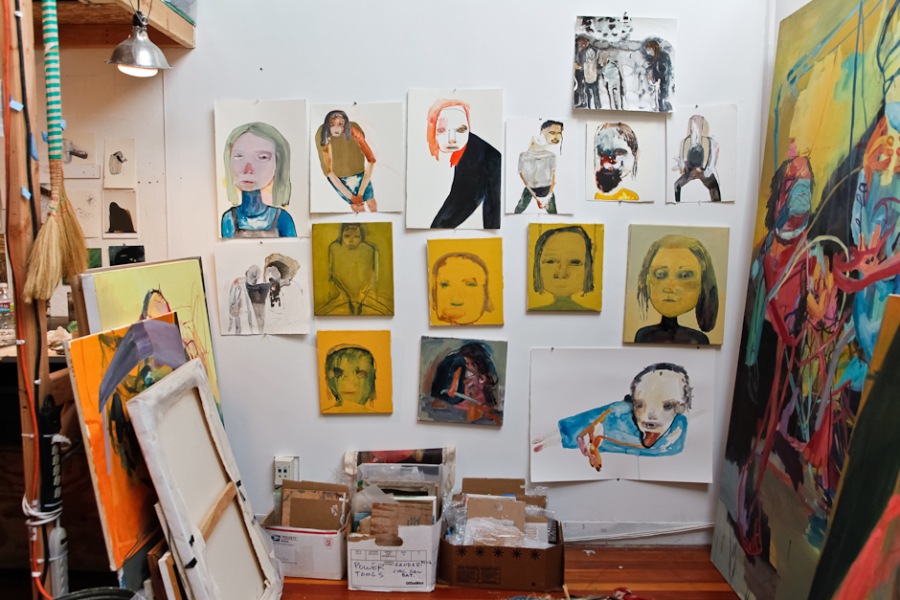
What mediums do you work with? How would you describe your subject matter or the content of your work?
Currently, I am mainly using ink and watercolor on paper. I am drawn to ink and paper because it feels like writing and it seems to activate the part of my brain that wants to tell stories. I used to work primarily with oil paint but there is something about the immediacy and fluidity of ink and watercolor that seems to keep me visually engaged. The immediacy and specificity of marks is important to me —unlike oil paint, you can’t go back into ink and watercolor. Going back to the writing metaphor, ink and watercolor do not allow me to edit, which is something I did obsessively when I painted with oil. Because I can’t edit I’m forced to be more honest, because for me the first gesture, that first instinctual action is often the most authentic. This formal quality translates well into my content where I try to maintain a level of sincerity and uncensorship. The figurative watercolor pieces I’m doing now are also less about formal aesthetic concerns and more about content and they are smaller as well, so there is a certain kind of thoughtfulness and intimacy about them that’s different than the oil paintings.
I think of my paintings as being visual journal entries, index cards or Polaroids. The content is largely taken from my daily life—conversations I overhear on the bus, an event I witness on the street, or a story that a friend tells me. As long as there is something psychologically or visually triggering, I have enough content to begin a painting. Small actions can reveal a lot— for example a person who is hunched over sitting on the bus, that action has a whole story behind it, and the hunch can become a metaphor for so many things.
I’m drawn to people on the periphery of society (derelicts, prostitutes, homeless, drug addicts, etc.), people who are psychologically distressed and in a state of deterioration, but who also have let social “masks” fall and who therefore present a more stripped down, truthful side to human experience. I have an affinity for these people because they mirror my own childhood refugee experience— there is that same palpable despair, unease and distress. My mother and I left Bosnia when I was 9 years old because of the Bosnian War and we spent three years in refugee camps, moving constantly from Slovenia to Austria and Germany, before finally arriving in the United States. There was a great sense of chaos and unrest during that time which has informed a lot of what I am curious about, and certainly created a need to record as a way of holding on to experiences.
When you are in need of inspiration are there particular things you read, listen to or look at to fuel your work?
When I look for inspiration, I go outside. I like to read all kinds of things, but it is not usually how I get my ideas. This may have something to do with the fact that I was an athlete in college (I ran track and field and cross country) and would spend my most precious moments outside, while running. So, I like to see things. I like to look at the sidewalk for different shades of gray. I love looking at walls of buildings that have been painted over and over due to graffiti. I don’t mind the gritty, greasy smell of the Mission—this is all information for my work. Things like this get my painting juices flowing. Right now, I am reading The Doors of Perception![]() by Aldous Huxley—an excellent book, but I don’t think its something that will make me run to the studio and paint. My favorite writer is Fyodor Dostoyevsky— Crime and Punishment
by Aldous Huxley—an excellent book, but I don’t think its something that will make me run to the studio and paint. My favorite writer is Fyodor Dostoyevsky— Crime and Punishment![]() . I am inspired by his writing in the sense that I strive for the psychological complexity that his characters have. The sense of simultaneously pitying a character and also being repulsed by their behavior is the kind of tension and instability I strive to achieve with my characters.
. I am inspired by his writing in the sense that I strive for the psychological complexity that his characters have. The sense of simultaneously pitying a character and also being repulsed by their behavior is the kind of tension and instability I strive to achieve with my characters.
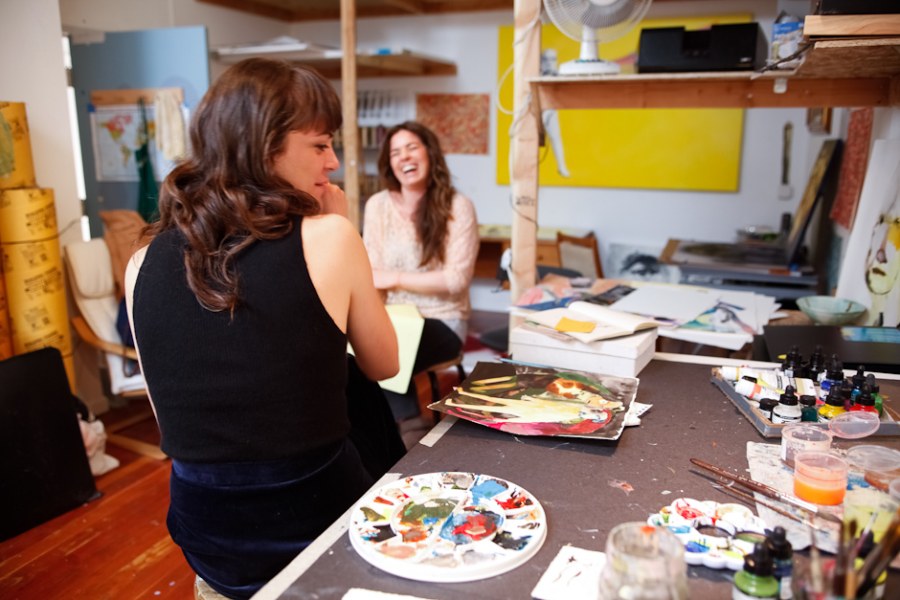
Do you see your work as autobiographical at all?
Yes, my work is definitely autobiographical—although I hope that it transcends my personal story and draws viewers into it. I have a deep interest in psychology and believe that childhood experiences leave strong imprints on the way we perceive the world later in life. Being raised without religion, yet having to flee my homeland because of a war caused by religion, fascinated me. I wanted to believe in something, so I started recording things around me in my sketchbook. It was almost like hoarding happenings. This became my way of being present in the world. My mother always encouraged this behavior, no matter how poor we were. She believed in the creative spirit and urged me to draw, paint and write.
Do you have a day job? What is it? What does it mean to you?
Yes, I work five days a week. I teach art to kids (first through fifth grade) through the San Francisco Recreation and Parks after school art program. I also teach an oil painting class once a week at UC Berkeley (through the ASUC center). I love teaching. It’s a challenge, but a good one. It forces me to verbalize things that are intuitive for me and I believe that this process makes me a better artist—a better person. Having to explain and articulate a method so that others can effectively engage and learn has made me think about my own process with more intention and really be more cognizant of why I’m making the choices I am in my work. Kids are inspiring and fun. They bring an element of humor and play that I believe is sometimes lacking in the art world. I can’t imagine not having to work. I don’t think I would like to be in my studio all day every day. My work is dependent on things that happen in life, so I need to be out in the word—engaged fully—just like everyone else and not just read about it.
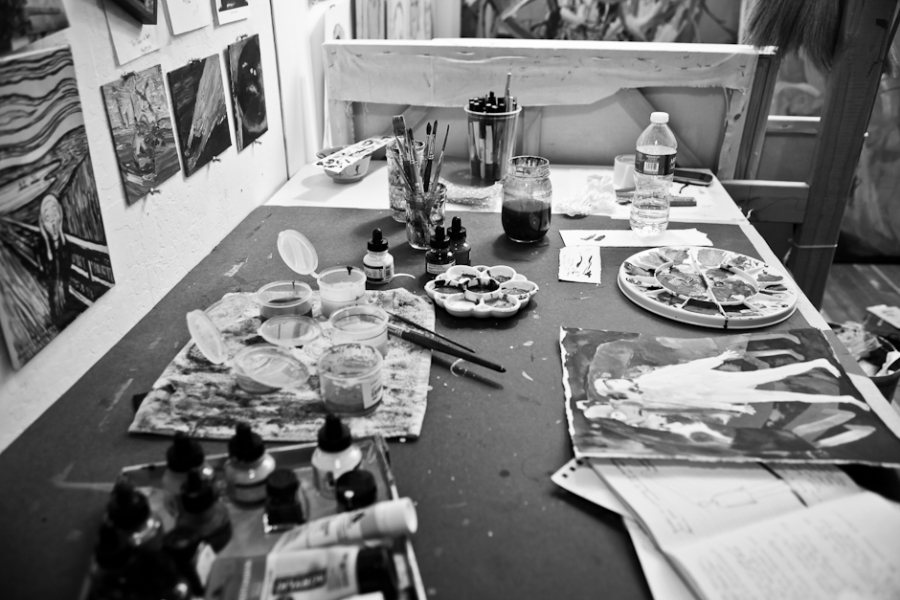
Have you had to make sacrifices in order to live your life as an artist? Do you encounter misconceptions about that life or choice?
I had a corporate job for one week! (laughs) I quit because it made me feel like a machine. Although getting a big check for just one week of work was enticing, going back to working retail and teaching gave me time to paint—and this was the crux of the matter. Will your high paying job allow you to be a painter? The answer was NO, so I quit and went back to being financially broke and spiritually satiated.
How do you navigate the art world?
This may sound naïve, but I don’t really spend much time thinking about the art world. It’s not interesting to me. I did not start painting because I wanted to be a player in the art world—I think this should happen naturally. When I was an athlete, I did not spend my days thinking about the Olympics, the medals or the sponsorships. I spent my time running, because that’s what mattered. Painting for me is similar—I truly, truly love it. Great things have been happening to me lately and I am extremely grateful, but it is not the reason why I will keep painting. My studio practice is my spirituality. It will be a part of my life whether or not I continue selling work.
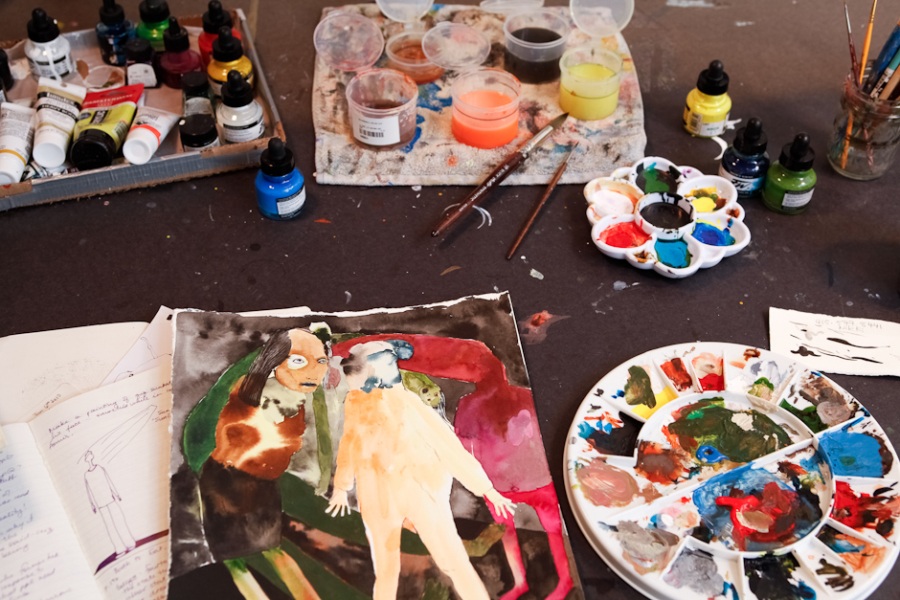
What do you think is the function of art in society? Do art or artists have a responsibility to do anything in particular?
I see artists as people who take things from life, re-arrange them, and then put them back out into the world. They are curious about various phenomena and use art as a way to communicate their ideas. I can’t speak for all artists, but I will speak for myself. I believe that my job as an artist is to share stories with people using a visual language that hopefully transcends the realm of spoken language. Although my work begins from a very personal place, my goal is not to make illustrations of my day-to-day existence, but rather painting for me is an opportunity to slow down and become more of an observer of life. I believe that personal stories are part of a larger, collective consciousness.
Who taught you the most about art?
I suppose, it was my mother, not in any direct way, but she always acknowledged the value of my artistic bent and allowed for its place in my life. When I was very young, before I could even read, I would play with her books and pretend that I knew how to read and make illustrations in the margins of what I thought the book was about. She never once scolded me for marking up her books, and that carried and continues to carry significance for me.
Do you have a motto?
If it feels important, it probably is!
What has been your biggest disappointment and greatest joy thus far in life?
My biggest disappointment has been finding out that I have permanent sciatic nerve damage (due to years of competitive running) four years ago. This meant a dramatic decrease in my weekly mileage. I used to run 50-70 miles per week and because of my injury, I was forced to accept light 30-45 minute jogs a couple a times per week. Being faced with a physical challenge after years of being a competitive athlete was a hard pill to swallow. Now, four years after the big news—I’ve learned to work around my physical limitations. Most importantly, all the extra time has given me more time to paint.
The greatest joy was when I went back to Bosnia three years ago (after being absent for nearly 17). Seeing my grandparents, cousins, neighbors and the old house where I grew up was life changing. I realized how fortunate I was to have a politically tuned in mother who fled Bosnia before it was impossible to do so. (It was hard to leave Bosnia a few months after the war started—we were lucky because we left right away). The trip itself was pretty depressing. The scars of war were easily noticed in the architecture as well as in people’s faces.
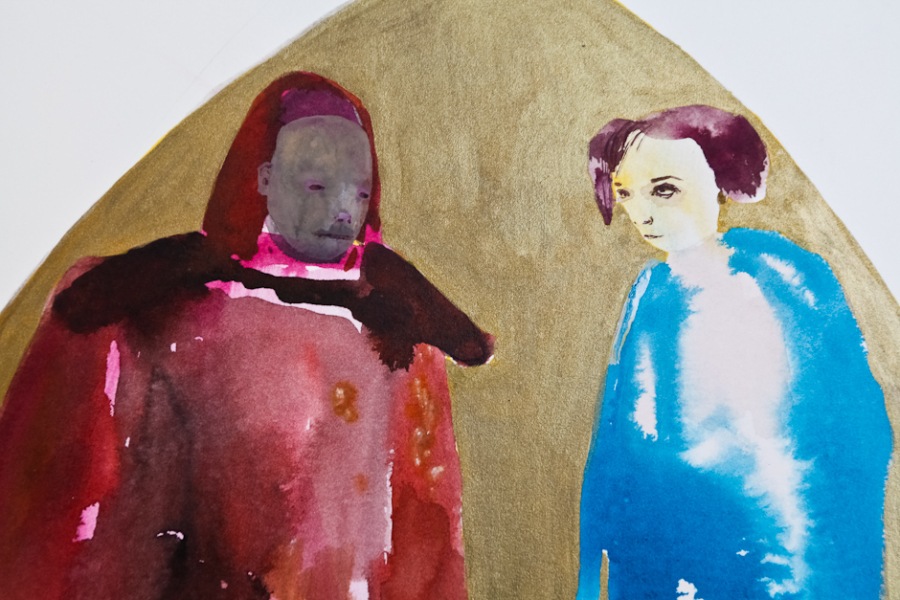
Is there something you are currently working on, or are excited about starting that you can tell us about?
I am currently working on a series of paintings in which I am attempting to intertwine the language of my larger, non-representational paintings with my smaller, more figurative works. I am figuring out how my characters exist in these chaotic landscapes that I worked on extensively while in graduate school at CCA. This is a fun challenge. I am cutting up some of my old sketches and arranging them around large color areas. This collage element is a great warm up exercise before I actually start painting.



